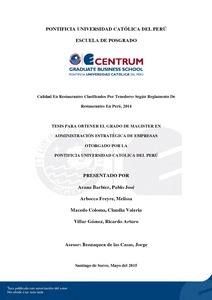El sistema se apagará debido a tareas habituales de mantenimiento. Por favor, guarde su trabajo y desconéctese.
Calidad en restaurantes clasificados por tenedores según reglamento de restaurantes en Perú, 2014

View/
Date
2018-05-30Author
Arana Barbier, Pablo José
Arbocco Freyre, Melissa
Macedo Coloma, Claudia Valeria
Villar Gómez, Ricardo Arturo
Metadata
Show full item recordAbstract
El presente estudio ofrece un análisis descriptivo acerca de la situación de la calidad en los
restaurantes en el Perú, específicamente aquellos clasificados por tenedores según Promperú,
en Lima Perú, 2014. El objetivo consistió en determinar el nivel de cumplimiento de los
nueve factores de éxito del Total Quality Management (TQM) para las empresas
mencionadas previamente, y que obedecen a la metodología que desarrolló el profesor
Benzaquen (2013). Ello fue complementado con un análisis del sector a nivel local y
mundial. La investigación obedece a un enfoque cuantitativo, no experimental, transeccional.
Al compararla con la teoría acerca de la calidad, permite ofrecer: (a) conclusiones, como el
diagnóstico de por qué algunos factores obtienen calificaciones altas y otros no; y (b)
recomendaciones, con el objetivo de mejorar a largo plazo la calidad en la industria. Todo
ello se logró luego de haber analizado los intervalos de confianza que permitieron proyectar
los resultados de la muestra hacia la población, y que llevan a la conclusión de que la
industria estudiada sí toma ciertas acciones a favor de la calidad The study hereby is a descriptive analysis of the quality of restaurants in Peru, specifically
such ranked with forks according to Promperú, in Lima-Peru, 2014. The goal consisted on
determining the level of compliance of the nine success factors of the Total Quality
Management (TQM) model for the enterprises mentioned previously, and which obey to the
methodology developed by Mr. Benzaquen (2013). It was well complemented with an
analysis of the sector nation and worldwide. The investigation obeys to a quantitative, non
experimental and transectional scope. By comparing the data to the theory about quality, it
lets to offer: (a) conclusions, such as the diagnosis of why some factors obtain high scores
and others do not; and (b) recommendations, with the objective of improving in the long term
the industry’s quality. All that was achieved after having analyzed the confidence intervals
which let project the sample’s results towards the population, and that lead to the conclusion
that the industry studied does take certain actions on quality’s favor
Temas
Calidad total
Restaurantes -- Perú
Investigación cuantitativa
Restaurantes -- Perú
Investigación cuantitativa
Para optar el título de
Maestro en Administración Estratégica de Empresas
Collections
The following license files are associated with this item:





